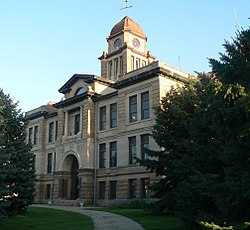2020 census
As of the 2020 census, there were 4,306 people, 1,702 households, and 1,131 families residing in the county. [14] [15] The population density was 5.1 inhabitants per square mile (2.0/km2).
Of the residents, 24.4% were under the age of 18 and 23.4% were 65 years of age or older; the median age was 42.6 years. For every 100 females there were 108.1 males, and for every 100 females age 18 and over there were 110.9 males. [14]
The racial makeup of the county was 84.3% White, 0.2% Black or African American, 7.8% American Indian and Alaska Native, 0.3% Asian, 1.8% from some other race, and 5.7% from two or more races. Hispanic or Latino residents of any race comprised 5.9% of the population. [15]
There were 1,702 households in the county, of which 26.1% had children under the age of 18 living with them and 17.0% had a female householder with no spouse or partner present. About 29.4% of all households were made up of individuals and 15.2% had someone living alone who was 65 years of age or older. [14]
There were 2,394 housing units, of which 28.9% were vacant. Among occupied housing units, 77.1% were owner-occupied and 22.9% were renter-occupied. The homeowner vacancy rate was 1.5% and the rental vacancy rate was 13.1%. [14]
2010 census
As of the 2010 census, there were 4,656 people, 1,815 households, and 1,154 families in the county. The population density was 5.6 inhabitants per square mile (2.2/km2). There were 2,534 housing units at an average density of 3.0 units per square mile (1.2 units/km2). The racial makeup of the county was 85.4% white, 7.6% American Indian, 0.2% black or African American, 0.2% Asian, 5.6% from other races, and 1.1% from two or more races. Those of Hispanic or Latino origin made up 6.8% of the population. In terms of ancestry, 45.6% were German, 30.6% were Norwegian, 6.8% were Swedish, 5.8% were Irish, 5.2% were English, and 2.7% were American.
Of the 1,815 households, 24.4% had children under the age of 18 living with them, 52.8% were married couples living together, 6.0% had a female householder with no husband present, 36.4% were non-families, and 31.4% of all households were made up of individuals. The average household size was 2.36 and the average family size was 2.83. The median age was 43.2 years.
The median income for a household in the county was $41,023 and the median income for a family was $56,544. Males had a median income of $31,639 versus $26,737 for females. The per capita income for the county was $22,441. About 9.3% of families and 17.1% of the population were below the poverty line, including 27.6% of those under age 18 and 12.8% of those age 65 or over.



